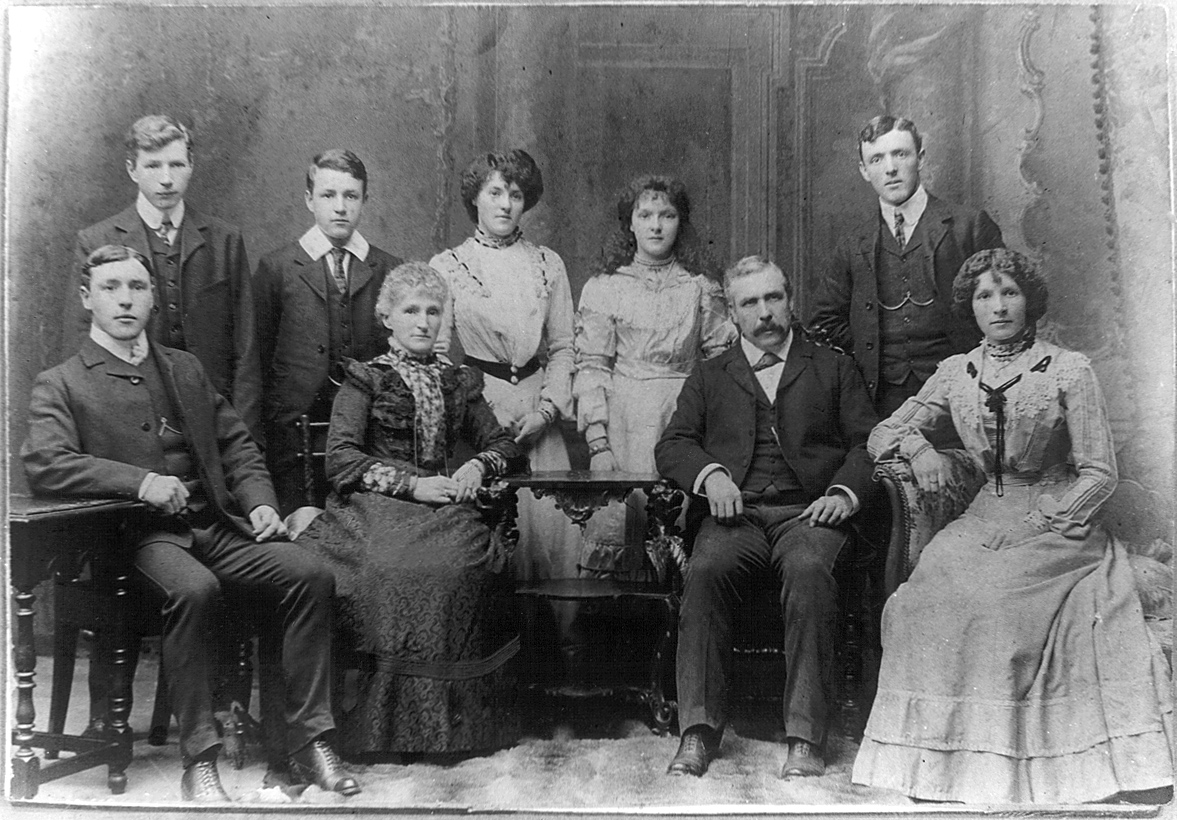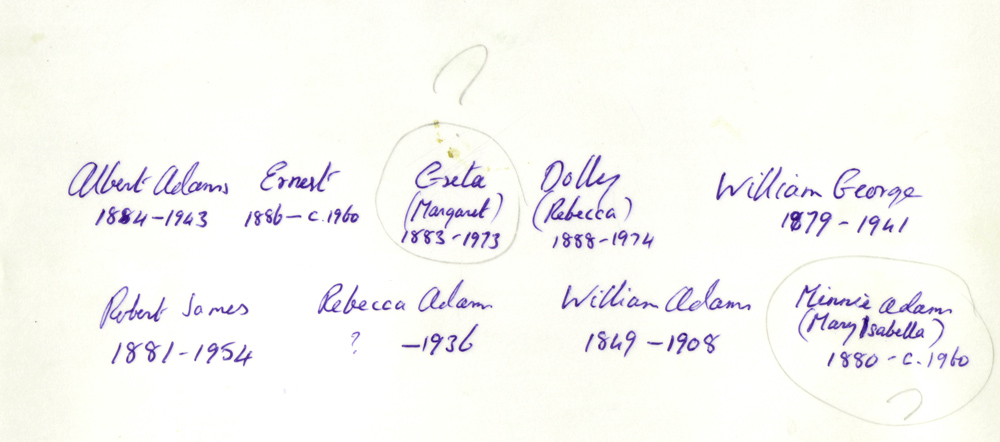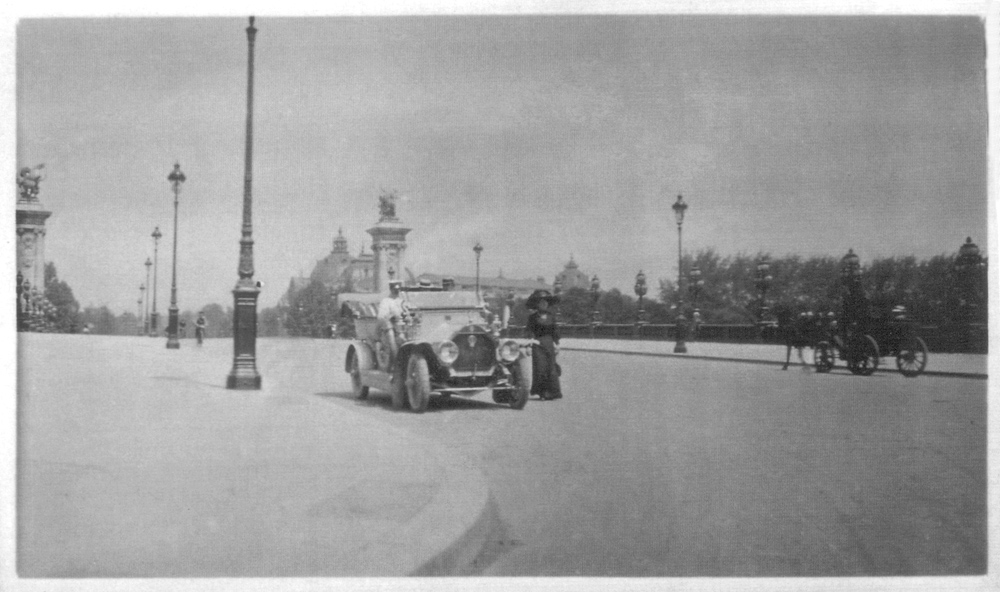|
The Adams Family, Belfast, c. 1900
Story goes, he came from Castledawson in Co Antrim. Walked to Belfast and, according to one version, started his career by selling newspapers, then thread and oddments of linen. We believe he was from farming stock, but whether a labourer or son of a small farmer, we just don't know. He was almost certainly descended from Scots who came to Ulster from the Lowlands, many from around Ayrshire, in one or other of the many migrations between 1100 and the 1800s. One version has William walking to Belfast barefoot but I suspect that may be a load of nonsense. If he was smart enough to start what was to become a big and very successful business, chances are he was bright enough to own a pair of boots. So. Who's who in the picture? The names are on this caption, written by Gammie not long before she died in 1995. Here's what I know about them.
Whether barefoot or not, William did start out by selling linen pieces, possibly as some sort of factory agent, or possibly from a tray in the street. We just don't know.
Soon he was doing well enough to rent a shop on Fountain Lane, in the centre of Belfast. Business prospered and he built (or probably bought) a linen warehouse in nearby Adelaide Street. Finally, he built a big, 'modern' linen mill at what is now the junction of Donegall Road and the M1 Motorway (by the roundabout at the junction of today's Boucher Road). The company he founded was William Adams and Co. The building has recently been demolished.
To the southwest of the factory lay the Bog Meadows, still a boggy area today, which to some extent then divided the Protestant south-eastern part of the city from the Catholic areas such as the Falls Road to the north-west. William was a Protestant but like many mill owners, he depended on employing both Protestants and Catholics and the location of his factory was ideal for this. We don't think he was particularly 'political' but he was pro-England and the Union and a pragmatic Presbyterian. He was born into a relatively quiet period of Irish history. The Troubles of 1916 were still eight years off when he died in 1908.
The factory made linen, mainly tableware. They specialised in double damask, the highest quality (double the number of threads in the patterns). The effect of so many silky threads in a small area is to produce a glossy pattern on a matt background. Very, very expensive to make - and looks it. This stuff lasts, seemingly, for ever. The company's brand was 'Derryvale Linen Co'.
What remained of William Adams & Co and the Derryvale brand was finally sold to Lamonts in 1998 by Michael Adams, Ronnie's son. By then, the firm was down to about 16 employees from more than 100 at it's height.
Like most Irish linen makers, as fashion changed, so Wm Adams & Co gradually had to shift emphasis to cheaper products such as tea towels. During the Great War they made linen for aircraft wings. During WWII they made uniform cloth. The firm grew quickly. Before the outbreak of war in 1914 they had already established offices in Belfast, London and New York. The first ever London 'phone book lists their office on page one of a thin little volume. The address, perhaps unfortunately, was 6 Gutter Lane, London EC2. Sounds much worse than it is. Gutter Lane was actually an historic andprosperous part of the City of London.
William seems to have been a bit of a philanthropist - he built his factory with gardens for the workers to sit and eat in, also a place for them to eat inside when it was cold or wet. He seems to have enjoyed genuine respect and perhaps affection from his workforce, which carried through into Ronnie's generation.
Who's Who?
Albert, 1884 - 1943 Son of William & Rebecca. Went to USA and ran the Derryvale Linen Co's office there at 20, East 22nd Street, New York. His first wife, Florence, ran off with another bloke. Albert sued him for 'alienation of affection' and won £10,000, a huge sum then. Later, he married Sherwood, a Christian Scientist. A good marketer, amongst Albert's promotions were advertisements in women's magazines and a book ' How to Set the Table for Every Occasion - With Some Facts About the Irish Linen Country & the Proper Care of Linens' by one, Sara Swain Adams (Sherwood, perhaps?) and published in 1921 by the Derryvale Linen Co, New York. He seems to have been a bit of a playboy and enjoyed the good life. The company did well in the USA between the Wars but when the Depression came, linen sales declined. Albert and Sherwood returned to Belfast in 1939 at the outbreak of WWII. Sherwood lived into her 80s in Belfast and, generously, left her money to the family's various younger generation women, including Louise (my mother), Joan, Kay, Margaret and Barbara (I think)
Ernest, 1886 - c.1960
Margaret (Greta or Toutie), 1883 - 1973 Daughter of William & Rebecca. Also, unusually, my Grandmother - she married Sam Baird, my Da's Da. Because Greta and James Adams were brother and sister, that made my mother (Christine Louise Adams) and my father (Donald William Baird) first cousins, which in those days was not exactly encouraged because it was thought the blood lines were too close... probably accounts for any peculiarities we may have. In fact, science now says there's no problem at all - provided you don't keep doing it in every generation. If you do, you may end up like the British Royal Family. Come to think of it, they're the wealthiest people in Britain, so perhaps a little intermarriage isn't all bad.
Although she doesn't look it here, Greta was a bit of a party girl, enjoyed the odd drink and a lively social life. Which is why, possibly, she married Grandpa Sam Baird, who was... shall we say, not really cut out for a life of hard work, much preferring a jar and a bit of a 'crack' in the pub with his friends (no, it's NOT spelt 'craic' and it's not an Irish word. English: to crack a joke? OK? In fact, 'Craic' is a completely made-up word, invented by the Irish Tourist Board in deference to gross and ignorant American tourists who apparently think crack is something entirely different - and I don't mean a drug) My last memory of Toutie, was of a small family group, Father over from New Zealand, Pamela, Uncle Alan, Toutie and me seated in the lobby of the Gresham Hotel, Dublin. Toutie, aged 80, sat sipping her drink and trying to convince me that a priest at the next table was giving her the eye. There were a lot of priests in Dublin's hotels in the 1960s, their regulation transport, black VW beetles, parked outside. Whether they fancied octogenarian ladies from Belfast is not known.
Sam Baird had inherited (I think) a carrier company, James Young & Co, which made him modestly well-to-do but fairly impoverished when compared to the wealthy Adams clan. I don't think this ever bothered him too much, but it sure did bother my father, Donald, and was partly why he headed off to NZ when he was 18, fed up with his dead-end job in an insurance company and playing the poor relation to his rich cusses. Those cousins included Ronnie and Joan and his future wife, my mother, Louise, who was a buxom outdoor girl, keen on horses, squash and badminton (played for Northern Ireland) and had been to an exclusive English girl's school, Battle Abbey, in Sussex, where she painted, played lacrosse and the church organ - although religion was definitely not her thing. Father went to Campbell College, Belfast, was none too academic, boxed and played a little rugby. At that time, Campbell was one of Ireland's leading public schools.
Sam and Greta lived off Belfast's Malone Road, before moving to a house on Princeton Road, Bangor - then, and still today, Bangor's dress circle (crude estate agent's phrase but describes the place quite well). At the beginning of WWII, Greta moved to London where she owned a boarding house in Holland Park. She returned to Belfast after the War and died in 1973.
James Young & Co had contracts with linen companies and Gallagher's Tobacco Company, mainly carting goods to and from the docks. When Sam died, Greta ran the business until her death in the 1970s, when it passed to Uncle Allan, my father's elder brother. It was sold in the early 1980s. Unfortunately, Toutie and my mother never did hit it off so I saw very little of her.
Rebecca (Dolly), 1888 - 1974 Daughter of William & Rebecca. 'Auntie Dolly' featured large in my early life, and not always for the good. She could be a bitter old biddy - although, to give her her due, she enjoyed the odd G&T and could be good fun on occasion. She became my mother's pal and ally when she returned from New Zealand in 1946 with yours truly, but she was a bit of a stirrer, family-wise. She had a daughter, Fay, who was very withdrawn and had mental health problems due to being born with a misshapen jaw. Today, Fay would have been operated on at birth and would have lived a normal life. Dolly married and moved to London when quite young. She returned to Belfast after the War, a widow with limited means, and lived a dull sort of life with Fay in a flat on the Malone Road, at the corner of Eglantine Avenue. A rather sad story.
William George, 1879 - 1941
Arthur married Vera and had a daughter, Adrienne. He took over as MD on the death of James (my grandfather) Not a great business brain, Arthur spent much of his time playing golf at Royal County Down Golf Club, Newcastle - a very smart club. No ladies were allowed on the premises, so Vera, when she dutifully called to collect him, had to sit outside in the car until he and his chums had finished watering at the 19th.
The rest of Arthur's time seems to have been spent rowing with other family members and making reactionary and sometimes amazingly stupid decisions, utterly frustrating his nephew, Ronnie, who worked under him, and the other shareholders, who wanted to modernise the business or at least have it properly managed. Once, briefly, in the early 1950s, the factory had made candlewick but the fashion for this ugly fabric came to a sudden end, leaving the warehouse filled with the unlovely stuff. Candlewick has an odd, raised tuft pattern, like a carpet someone has shaved bare in patches. Years passed. Then a lone buyer arrived in Belfast, snapping up whatever candlewick was available. Arthur held out for a better price, believing, against all reason, that the long defunct candlewick market would recover. It never did. When the warehouse closed in the 1980s, the place was stacked high with the stuff... So, if you ever wonder why, sometimes, we Bairds do odd things and don't seem quite as smart as we might be, blame the Arthur gene.
Robert James (James), 1881 - 1954 (left, front row)
James married Sarah (Sally) Henderson (nee Steel), a widow from Ayr. When courting her, he used to take his car on the ferry to Stranraer so as to take her for outings. At the time, taking cars from Ireland to Scotland was almost unheard of and in Ayr he was nicknamed 'the wee mad Irishman'. One picture shows them, appropriately, at Gretna Green with his huge touring car and chauffeur. Sarah had been married to a very bright academic, Dr Henderson, who had a string of degrees. He had been a Presbyterian minister but left the church saying he 'could not practice what he preached', went back to university and got a medical degree.
Sarah had a son by Dr Henderson, Hubert,who lived with James and Sarah in Belfast. On the outbreak of war in 1939 Hubert volunteered, as a private soldier, joined the London Irish Rifles, later being commissioned as a lieutenant. He was killed in Tunisia, North Africa, on 13 January 1943 at the battle of Two Tree Hill. His body was never found.
James and Sarah had three children: Christine Louise (my mother) Ronald James (Ronnie) and Joan. The family lived in 'Moyola' in Adelaide Park, Belfast. James eventually bought a summer house, 'Warrendene', in The Warren, Donaghadee (still there). During the summer months, the family moved with maids, dogs, cars, guns, rods etc etc to Donaghadee, where they swam incessantly, played golf, ate ice cream at The Cabin (Louise for a dare once ate £1 worth. Ice cream cones then cost 1 penny each and there were 240 pennies to £1 ...) James went 'to business' most days by train.
James dominated Ronnie, apparently, but bought him cars to race, so it can't have all been bad. James flew with Ulster aviation pioneer, Henry Farman. He toured France in his father's car at a time when there were very few cars anywhere at all (C. 1910. See the picture above). And he loved to fish salmon and trout. He had a beat on the river Bann and various vehicles were used for fishing trips and family holidays at Miss Henry's farm, near the Bann or at Port Salen Hotel, Donegall (still there although rebuilt after a major fire). One vehicle was a bread van converted into a sort of camper, in which James would sleep whilst on fishing trips. He also had a Crossley Tender, used by the servants to carry picnics and transport stuff between the households. The Crossley was probably ex-War Department - this sort of truck being used by the infamous Black and Tans in the 1914-18 period, causing consternation when it first appeared in one village where a woman ran away screaming, 'The Tans are back!'
The children were sent to various boarding schools in England, Louise at the age of 9 - she was 'difficult' apparently, to Wellington School in Ayr and later to Battle Abbey, in Sussex (on the site of that battle..) In Ayr, at weekends she stayed with her mother's sister, Auntie Teen(a) Steel at Clyde House (now council offices or possibly flats on the extreme southern shore end of Ayr. The Steeles were successful race horse owners and Clyde House had a yard with stables (and a pet monkey which died of prosperous poisoning having chewed on some brass cartridge cases. Moral: never eat bullets) Sarah's. Sarah's cousin, Finlay Wilson owned Adam Wilson & Sons, still today a major Scottish timber mill, based in Troon near Ayr and run by Finlay's son, Hamish. In 1935, with the business suffering from recession, Joan was withdrawn from boarding school.
Rebecca (nee Duncan) ? - 1936
William Adams, 1849 - 1908
Mary
Isabella (Minnie), 1880 - 1960
|


